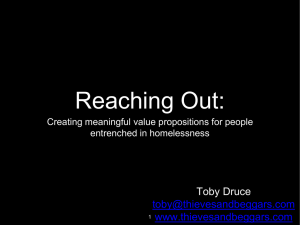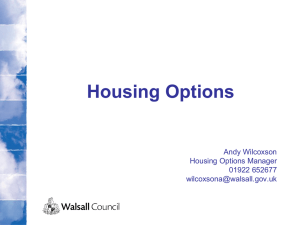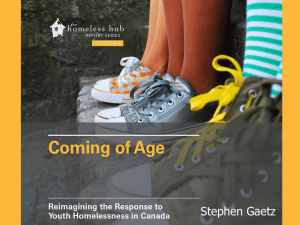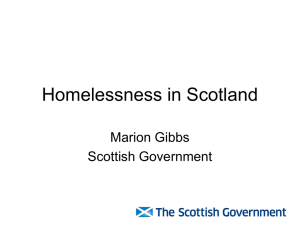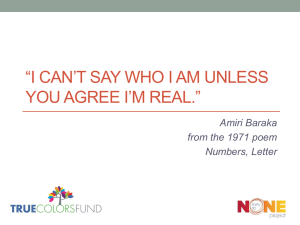Homelessness is TOXIC STRESS - The National Association for the
advertisement
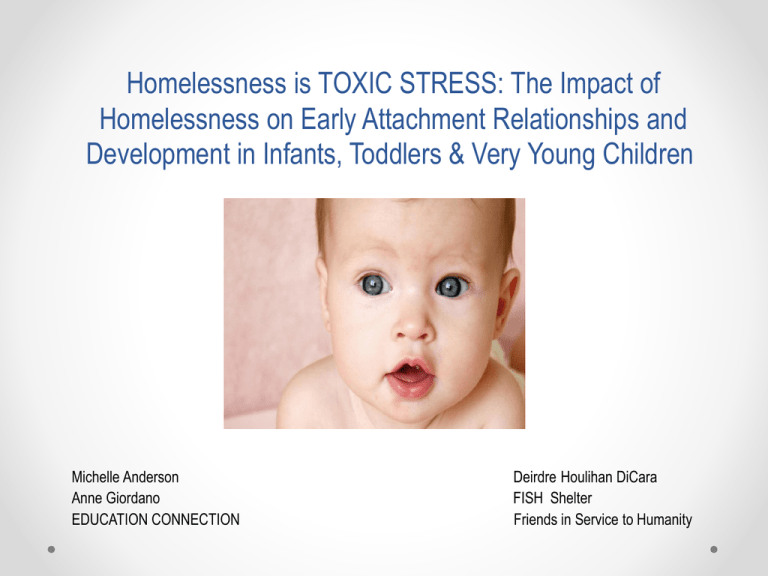
Homelessness is TOXIC STRESS: The Impact of Homelessness on Early Attachment Relationships and Development in Infants, Toddlers & Very Young Children Michelle Anderson Anne Giordano EDUCATION CONNECTION Deirdre Houlihan DiCara FISH Shelter Friends in Service to Humanity Agenda Welcome & Introductions Training Objectives for Participants: Understand the Relationship Between Homelessness and Toxic Stress Understand How Homelessness Impacts Attachment Relationships and Development Learn Successful Strategies for Engaging Families Learn Strategies for Working Collaboratively with Community Partners (Adapted from presentation with Roseanne L. Flores, Ph.D., at the Head Start, 11th National Research Conference, 2012) Introduction Homelessness has often been viewed as an extreme form of poverty, influenced by an “accumulated lifetime exposure” to environmental risks.1 One woman experiencing homelessness described it as, “a remarkably constant stream of distressing and spirit – breaking encounters, beginning in early childhood”, including lifelong poverty, parental neglect, exposure to domestic violence, childhood abuse (including sexual abuse), and unhappy and painful interpersonal relationships.2 Why this Matters: Demographics & Numbers US public schools identified 1,168,354 homeless students in 2011-2012 3 More than half of children living in HUD funded shelters in 2012 were under the age of 6: 3 Under age 1 = 33,044 Ages 1-5 = 134,631 One third of the homeless population are families: 60% of homeless women have children under the age of 18 42% of children in homeless families are under the age of 6 20% of homeless youth become pregnant 25% of very young children experiencing homelessness evidenced poor social emotional development o Homelessness during infancy & toddlerhood linked to early school failure and child welfare involvement o Homeless in early childhood associated with poor social skills and classroom engagement in o o o o elementary school 3 CT Child Statistics • CT has approximately 108,000 infants and toddlers and 75,000 preschoolers: • 17% are living in poverty • 5.5% are born to teen mothers • 12% are born to mothers without a high school diploma • 22% of mothers have inadequate prenatal care • 7.7% are born low birth weight • 20.7% enter kindergarten without having attended preschool • 6,965 children were abused or neglected in last year reported (all ages) And because we know that…. • “What happens in the first three years of a child’s life has a direct and enduring impact on a child’s future learning, behavior and health.” Lisa Honigfield, Ph.D., CT Child Health & Development Institute (CHDI) Key Terms: Attachment Toxic Stress Definition of Attachment Attachment is the ongoing emotional bond that the child builds with a familiar adult through a nurturing relationship. Infants and toddlers who are building attachment relationships tend to seek and maintain closeness to important people in their lives, especially during stressful situations. When infants and toddlers have healthy relationships that support attachment, they learn to trust that the world is safe, and they have the confidence to explore and learn! (DECA –for Infants & Toddlers) Attachment & the Impact on First Relationships • The ways in which primary caregivers interact with their babies in their first years of life provide the answers to these critical questions about the baby’s sense of security: o o o o Is my environment safe for exploration and learning? Can I count on someone to respond to my needs? Am I worthy of attention? Are people trustworthy? Secure Attachments: When a primary caretaker meets the social and emotional needs of a child in an appropriate, consistent manner, that child feels safe and secure in the attachment relationship: • Acts as a protective factor. • Helps promote cognitive functioning…if a child feels safe, they have lower stress levels, so they can stay regulated and maintain low cortisol levels (stress hormone). • Allows children the freedom to explore their environment, and learn! Insecure Attachments: • May occur when caregivers do not respond to their child’s distress signals in a consistent manner. • Inhibits emotional & cognitive development. • Higher stress results in high levels of cortisol (stress hormone), resulting in unregulated & insecure children. • Leaves children less likely to explore their world and take in new experiences. • Negatively affects children’s relationships into adulthood. Leads to the Formation of the Child’s Internal Working Model: • Positive • Negative Positive: Develops when caregivers are nurturing, consistent, loving & empathic- child’s internal voice says• • • • “I am loveable” “I can trust others” “I deserve to be happy” “I am capable of making others happy” Negative: Develops when caregivers are punitive, abusive, neglectful, rageful, or self-absorbed- child’s internal voice says•“I am incapable of being loved” •“I cannot trust others” •“I am trouble to be around” 3 Types of Stress Responses • • • Positive Stress Tolerable Stress TOXIC STRESS Positive StressA normal and essential part of healthy development (working on a challenging task, getting an immunization, entering childcare, starting a new job, etc.) Tolerable StressIf the situation is time-limited, and is buffered by positive relationships and support from trusted adults who help the child adapt- the brain and organs recover (divorce, loss of loved one, frightening injury, etc.) TOXIC STRESS Occurs when a child experiences strong, frequent/and or prolonged adversity- without the buffering of adequate adult support 4 Definition of Toxic Stress (cont.) • Examples can include: physical or emotional abuse, chronic neglect, caregiver substance abuse or mental illness, exposure to violence, and/or the “accumulated burdens of family economic hardship”.4 (ex. homelessness) • Toxic stress disrupts the development of brain architecture and of other organ systems.4 Toxic Stress and Homelessness • The prevalence of traumatic stress in the lives of families experiencing homelessness is extraordinarily high and on-going: o childhood abuse and neglect o family disruption & loss o domestic & community violence o involvement with the foster care system o trauma associated with the loss of home, safety and sense of security 4 ACE Study: Adverse Childhood Experiences • Conducted by Kaiser Permanente from 1995-1997 5 • 17,000 participants • Measured exposure and frequency of early experiences prior to age 18, including: o Abuse (physical, emotional, sexual) o Neglect (physical, emotional) o Household Dysfunction • Mother treated violently • Parental substance abuse • Parental mental illness • Parental separation/divorce • Incarceration of family members Frequency & #’s of ACE’s are strongly correlated to future mental health & social complications: • • • • • • • • Alcoholism & substance abuse Depression Fetal death Risk for intimate partner violence STD’s and multiple sexual partners Adolescent pregnancy Smoking Suicide ACE’s also linked to future health/medical complications: • • • • • COPD Heart disease Liver disease Obesity Health related “quality of life” issues Toxic Stress and Homelessness Children in homeless families experience more stress in their lives, and at early ages.3o o o o o fear that something bad will happen to their families high rates of family separation >12% of homeless children are placed in foster care 83% are exposed to a serious violent event by age 12 anxiety over having a place to live or sleep at night Characteristics of Homeless Families Mothers who are homeless often are: 6, 7 o poorly educated o o o o o o o unemployed lacking in employable skills earning incomes significantly below FPL experiencing acute and chronic physical, dental & mental health issues limited in access to adequate health care have high rates of substance abuse, severe mental health disorders exposed to physical, emotional & sexual abuse, both as children & adults Characteristics of Homeless Families Young children who are homeless often demonstrate: 8,9 o o o o o poor educational outcomes poor school performance poor health (chronic ear infections, asthma, gastric issues, skin issues) developmental delays (cognitive, speech & motor) behavioral/mental health issues And: o experience hunger, disturbances of sleep o lack appropriate toys & resources Impact of Homelessness on Pregnancy Women who are pregnant & homeless are most likely:10 o o o o o o o o o o young/adolescent highly stressed socially isolated malnourished poor undereducated/unemployed experiencing physical/mental health issues experiencing/have experienced abuse lacking needed social supports to have poor relationship histories Impact of Homelessness on Pregnancy Homelessness interferes with establishing the positive prenatal characteristics that promote optimal development for the newborn, including:11,12 o o o o o adequate prenatal care mentally preparing for parenthood logistically preparing for the birth forming impressions of the new baby visualizing where the baby will “be” o These all promote the early formation of positive, secure attachment patterns Impact of Homelessness on Infants Primary developmental task of infancy is to establish security & trust—parents’ task is to support the infant through responsive and consistent caregiving.13 Homelessness works against this primary developmental task due to:12 o o o o o unpredictable & inadequate physical environments inability to meet basic needs exposure to extreme temperatures overcrowded & over stimulating living conditions possible presence of multiple adult caregivers Impact of Homelessness on Infants Infants may become emotionally flooded and overcome with hunger, physical discomfort, & frustration.14 Infants may be negatively impacted by loss of mother’s emotional response & availability, leading to insecure attachment patterns.14 Consequences can lead to high rates of emotional, physical, health, & developmental issues, & cognitive, motor & language delays.14, 15 Impact of Homelessness on Toddlers Primary developmental task of toddlers is to develop self-regulation & identity—parents’ task is to support the toddler through scaffolding for regulation and the provision of a safe, secure environment.13 Homelessness works against this primary developmental task due to:16 o o o o o o poorly maintained & unsafe environments restrictions on toddler’s opportunity for free exploration pressure on parents to manage behavioral outbursts & power struggles feeling of parenting under a “microscope”—leads to embarrassment absence of developmentally appropriate materials & activities parents’ autonomy to make decisions is sometimes limited due to shelter routines Impact of Homelessness on Toddlers Toddlers may begin to demonstrate reactions to continual stress including:13 o o o o o o o o o o o feelings of insecurity distrust fears loss of skills frequent illnesses irritability stagnancy in developmental skills regression in developmental skills development delays in social, cognition, communication & motor skill development behavioral issues issues of sleeping & eating Impact of Homelessness on Preschoolers Primary developmental tasks of preschoolers are to develop recognition of emotional states of others, separating from parents, and to develop social competence with peers & adults—parents’ task is to provide the preschooler with external support in understanding social situations and facilitating relationship building with peers & adults.13, 17 Homelessness works against these primary developmental tasks due to: o o o o inability to provide a structured & organized environment 18, 19 inability to provide books & toys that promote development 18, 19 parents under stress may themselves model poor interpersonal skills with others18, 19 unruly behavior in children as they get older may cause eviction resulting in additional stress1 Impact of Homelessness on Preschoolers Preschoolers may begin to exhibit:20 o o o o o o o o o difficulty with peers intense emotional reactions feelings of boredom frequent illnesses anxiety developmental stagnancy or regression developmental delays in cognition, communication & school readiness skills externalizing behaviors in order to exhibit a sense of control issues of sleeping & eating So… what can we do???? • Think about the following statement by Bruce Perry, M.D. o “There is no more effective neurobiological intervention than a safe relationship…..it changes the brain.” It’s all about the relationship! • Think about the “parallel process”… “do unto others as you would have others do unto others” (Jeree Pawl, 1998). • Parents cannot give what they haven’t received themselves … or may have lost along their journey. • In order for parents to be able to offer a sense of security to their children… we must first offer it to them! • Remember that “how we are”…… is often more important than what we do!!!!!!! So.. How do we do it? • We must first create opportunities for parents to feel: • Safety • Security • Respect • Trust • Dignity Examples in action…… McKinney Vento Grant CoordinatorMichelle Anderson FISH Executive DirectorDeirdre Houlihan DiCara Builds strong relationships with shelter staff, early childhood providers & schools- leads to early identification and immediate connection to families Instills “family atmosphere” into all aspects of shelter life: holidays, family meals, birthday celebrations picnics, etc. Streamlined identification processes & Hosts baby showers –encourages forms- timely response & reduces attachment building chance of missing referrals Promptly meets with families one-onone; provides concrete assistance which promotes security Promotes sense of “pride” among residents by encouraging their participation in community events Conducts developmental screenings to Attends child events: graduations, identify children at risk for award ceremonies, etc.- promotes self developmental concerns concept Conducts on-site playgroups in shelter-encourages positive child/parent interaction Invites past residents back to shelter for family dinners- maintains sense of connection & relationships Treats all with respect & dignity! Treats all with respect & dignity! Practices to Support Positive Outcomes for Young Children & Families! Reflections from the team…… • How do we impact and reach out to young children in our community? What supports do we offer? o Collaborations & Partnerships are KEY! • McV Sub-grant Coordinator & Shelter Director have strong partnerships with: o Shelter staff- allows for timely identification & connections with families! o Local Continuum of Care o Superintendent & every school social worker o City officials & civic organizations o Community Foundations (funding opportunities) o Local library, child enrichment programs o Early Care Programs: PAT, HS/EHS, B-3, Child First, childcare centers, etc. o On-site shelter services in place: • Home visits to families with children at FISH & SBA • Developmental screenings conducted (ASQ); referrals as needed • Playground & Library established with HS funding • Birthday Parties/holidays/baby showers • GED, life skills, cooking classes • Job preparation Continued….. • Direct supports for children & families: o o o o o o o o o o Camperships & enrichment programs Clothing Backpacks/school supplies/athletic equipment Early care tuition Baby supplies Books, toys Food resources Tuition to school clubs, class trips, programs Tutoring Transportation supports • Partnership Successes: o o o o o o o Annual Homeless Connect event (Children’s Corner) First Book grant award of free books Local donors (i.e.: Walmart cards, etc.) Local grant awards Caseworkers at FISH & SBA are well established- allows for direct contact Local officials, legislators, and school administration on board! Strong collaborative history in our community! But as always… there are barriers! • • • • • Lack of available slots to enroll children in early care programs! Transportation is basically non-existent in our area Few shelter beds exist in our community Lack of affordable housing TRUST… always a work in progress Strategies for accessing early childhood services Identify existing early childhood programs in your community Connect with key early childhood stakeholders Advocate for slots for homeless children within early childhood programs; be “flexible” with requirements Include “homelessness” in selection criteria for enrollment by classifying homelessness as an “at-risk” factor Designate a “young child” contact at each homeless service program (homeless/DV/ emergency shelters) in your community Provider Strategies for Successful Home Visits with Homeless Families! Be willing to meet families where they are…even getting to a program a few blocks away can be overwhelming—schedule as much as possible on site where they are. Be aware that the “multiple provider” approach can be intimidating and confusing to families—sometimes fewer is better! Offer a variety of locations to conduct home visits— shelter, library, coffee shops, other scheduled appointments the family already has— sometimes this is the only privacy they have. Provider Strategies for Successful Home Visits with Homeless Families! Schedule regular visit times to shelters that you are available (i.e. every Thursday morning) rather than individually set appointments— sometimes better results. Be flexible—“think out of the box”—and willing to adapt & stretch some program rules to better fit family situation. Q-TIP: Quit Taking It Personally! Just because a family doesn’t follow through with you, doesn’t mean it is about you or their interest in being the best parent they can be…it may be just all they can do at that particular moment. Provider Strategies for Successful Home Visits with Homeless Families! Focus on “what you can do” instead of “what you can’t do”… accept and expect that there are many barriers to serving this population. Offer respect and listen—sometimes that is enough! Remember that it “is all about the relationship”—recognize that you must build trust first, and even then, it can be challenging to keep families engaged with you at times. Presenter Contact Information Michelle Anderson EDUCATION CONNECTION torringtonfrc@educationconnection.org 860-489-8552 Anne Giordano EDUCATION CONNECTION giordano@educationconnection.org 860-567-0863 X 236 Deirdre Houlihan DiCara FISH/Friends in Service to Humanity ddicara@fishnwct.org 860-482-7300 / 860-605-5135 Resources http://www.naehcy.org/early.html http://www.horizonsforhomelesschildren.org http://www.familyhomelessness.org http://www.serve.org/nche References • 1David, D.H., Gelberg, L., & Suchman, N.E. (2012). Implications of homelessness for parenting young children: A preliminary review from a developmental attachment perspective. Infant Mental Health Journal, 33(1),1-9. doi: 10.1002/imhj.20333. • 2 • 3Demographic • 4Center • 5 ACES: • 6Bassuk, • 7Rog, Styron, T. H., Janoff-Bulman, R., & Davidson, L. (2000). “Please ask me how I am:” Experiences of family homelessness in the context of single mother’s lives. Journal of Social Distress and the Homeless, 9(2), 143-165. doi: 10.1023/A:1012945602583. information was extracted from The National Center on Family Homelessness (2011). The characteristics and needs of families experiencing homelessness. Retrieved from http://www.homelessness.org/media/306.pdf. on the Developing Child Harvard University. (2012). Toxic stress: The facts. Retrieved from http://developingchild.harvard.edu/topics/science_of_early_childhood/toxic_stress_response/. The Adverse Childhood Experience Study. http://www.acestudy.org/index.htm E. L., Buckner, J. C., Weinreb, L. F., Browne, A., Bassuk, S. S., Dawson, R., & Perloff, J. N. (1997). Homelessness in female-headed families: Childhood and adult risk and protective factors. American Journal of Public Health, 87(2), 241—248. doi: 10.2105/AJPH.87.2.241. D. J. & Buckner, J. C. (2007). Homeless families and children. Toward Understanding Homelessness: The 2007 National Symposium on Homelessness Research. Retrieved from http://aspe.hhs.gov/hsp/homelessness/symposium07/rog/index.htm. References • 8Haber, M. G., & Toro, P. A. (2004). Homelessness among families, children and adolescents: An ecological-developmental perspective. Clinical Child and Family Psychology Review 7(3), 123-164. doi: 10.1023/B:CCFP.0000045124.09503.f1. • 9Better • 10Bassuk, • 11Bassuk, • 12Galinski, • 13Sroufe, • 14Easterbrooks, • 15Garcia Homes Fund. (1999). Temperament and attachment security in the strange situation: An empirical rapprochement. Child Development, 58(3), 787.795. doi: 10.2307/1130215. E. L. & Weinreb, L. (1993). Homeless pregnant women: Two generations at risk. American Journal of Orthopsychiatry, 63(3), 348-357. doi: 10.1037/h0085034. E. L. (1991). Homeless families. Scientific American, 265(6), 66-74. E. (1981). Between generations: The six stages of parenthood. New York, NY: Berkeley. L. A., Egeland, B., Carlson, E. A., & Collins, W. A. (2005). The development of the person: The Minnesota Study of Risk and Adaptation From Birth to Adulthood. New York, NY: Guildford Press. M. A. & Graham, C. A. (1999). Security of attachment and parenting: Homeless and low-income housed mothers and infants. American Journal of Orthopsychiatry, 69(3), 337-346. doi: 10.1037/h0080408. Coll, C., Buckner, J. C., Brooks, M. G., Weinreb, L. F., & Bassuk, E. L. (1998). The developmental status and adaptive behavior of homeless and low-income housed infants and toddlers. American Journal of Public Health, 88(9), 1371-1374. doi: 10.2105/AJPH.88.9.1371. References • 16Smolin, A. G. (2003). Children born into loss: Some developmental consequences of homelessness. Journal of the Psychoanalysis of Culture and Society, 8(2), 250-257. Retrieved from http://muse.jhu.edu/journals/journal_for_the_psychoanalysis_of_culture_and_society/v008/8.2smolen.html. • 17Hausen, • 18Heinicke, • 19Averitt, • 20From B. & Hammen, C. (1993). Parenting in homeless families: The double crisis. American Journal of Orthopsychiatry, 63(3), 358-369. doi: 10.1037/h0079448. C. M. (2002). The transition to parenting. In M. H. Bornstein (Ed.), Handbook of Parenting (2nd ed., pp. 363-388). Mahwah, NJ: Lawrence Erlbaum Associates. S. S. (2003). “Homelessness is not a choice!” The plight of homeless women with preschool children living in temporary shelters. Journal of Family Nursing, 9(1), 79-100. doi: 10.1177/1074840702239492. a presentation given by Nancy Suchman, Ph.D. , Associate Professor, Yale University School of Medicine. Mothering from the Inside Out: Promoting Reflective Parenting in At-Risk Mothers Caring for Young Children. Sponsored by, CT Association for Infant Mental Health, April 2012.




